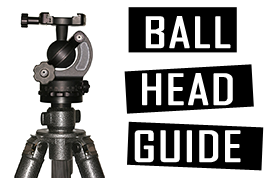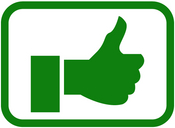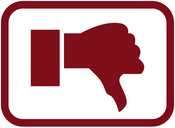The Ultimate Ball Head Guide

A tripod is not a single piece of equipment, but rather, two components joined together: the legs and the head. In this article, we'll explore a specific type of tripod head called the ball head, or more formally the ball and socket head.
A tripod head, in general, is the piece of equipment that sits between your camera and the tripod legs. It is responsible for providing an adjustable yet rigid connection. It's also the part of the tripod that you, the photographer, will have the most interaction with.
A recent poll here on Epic Edits indicates that 60% of you are ball head fans when it comes to your tripod heads. But for those of you who aren't on board already, read on!
WHAT IS A BALL HEAD?
A ball head is a ball and socket joint that allows rotation about a single point in all directions. They are typically more compact than a traditional pan/tilt head or other forms of tripod heads because they only require a single mechanism for locking the motion. But rather than try to describe how a ball head works, I found this video that does a decent job at showing how they work and how they move.
The ball head in this video is equipped with more features than you might find on some other heads. Panning capabilities and quick release mounts are not inherently available on all models of ball heads. For further reading on ball heads, tripod heads, and tripods in general, see the following articles: Tripod Heads 101 and Choosing a Tripod or Monopod.
WHAT ARE THE ADVANTAGES?

One of the major advantages of using a ball head is the simple operation it provides. A single knob is faster and easier to operate than multiple handles and levers. While one hand takes care of the knob, the other can be on the camera and positioning it as you look through the viewfinder. When you find that spot you're looking for, give it a twist and away you go.
In addition to the simple activation of controls, the motion provided is equally elegant and simple — you might even say intuitive. A full range of rotation means there are no limits to which direction you can point the camera, and the motion feels quite natural and uninhibited. Your own hips and shoulders work on the same basis as the ball head: the ball and socket joint.
But besides the ergonomics and ease of use of the ball head, they're also generally more compact than a pan head. There are no adjustment arms that hang off the head, and the single socket can be designed to occupy much less space than three separate hinge joints.
Plus they look cool.
WHAT ARE THE DISADVANTAGES?

Now of course there are downsides to every good thing out there. In the case of the ball head, it's mainly the price. For a ball head of equal quality and capability to a pan head, the ball head will almost always cost more money. The main reason they cost more is because that precision ball and socket joint is much more difficult and expensive to manufacture than three decent clutched hinges.
The other downside of the ball head is with the strength and precision. Ball heads that are comparable in price to pan heads will typically support less weight (important for folks with big heavy lenses). The motion and the ability to stop the motion will also be of lower quality and capability than the pan head. It's not to say that you can't get a ball head to carry a heavy load with smooth operation — it's just going to cost more.
Another disadvantage of some ball heads is in the lack of a panning mechanism. Higher end models will have this capability, but many will not (or they'll do it poorly). And if they do have a panning option, the control for this motion will almost always be a second knob, lever, or button. So if you're into serious panorama shooting, you might want to hang on to your pan head (or even a specialized panorama head).
WHAT FEATURES SHOULD I LOOK FOR?
If you've ever shopped for any kind of photography equipment, you'll know that there are enough options out there to drive you nuts. Things are only more difficult if you don't know what features you should be paying attention to. So if you're looking to purchase a ball head, here are some things you ought to consider.
- WEIGHT CAPACITY
If you're shooting with a big heavy SLR and a gigantic telephoto lens, you'll need to know your weight and check that the head is capable of carrying it. On the flipside, if you're using a compact camera, you don't need to spring for the head that can carry 45 lbs. - ANGLE OF MOTION
Check to see that the head can tilt to a full 90 degrees — most have a groove for the shaft to fall into that allows for this. If it doesn't, you can't frame vertical shots without really tweaking the tripod legs. And if you're concerned about panning, you'll want to look specifically for that added feature. - NUMBER OF CONTROLS
All ball heads need at least one knob or other control, but some will have more. Generally, those extra knobs are for added features such as panning and other types of limited movement control. These are usually good things, but if you don't need those features, don't pay for them. - CAMERA ATTACHMENT
Every ball head manufacturer seems to have a different way of attaching the camera. One thing to pay attention to is what the ball head offers by way of a quick release or some other mechanism. No two types of quick releases are the same, so keep your eyes peeled for good reviews — or hit the camera store and try them out. - LEG ATTACHMENT
Just as important as the camera attachment is the tripod leg attachment. Make sure the ball head you're looking at is compatible with the legs you already have (or are also looking at). Most of them are pretty standard connections, but some have specialty setups. If you're unsure, buy the two as a set or at least stick with the same brand. - YOUR BUDGET
And finally, don't forget your budget. As with any photography equipment, you get what you pay for — but you still need to set your limits. Place boundaries on your spending before you start getting attached to a new ball head, but if you're serious about making an investment on this piece of equipment, allot yourself as much as possible.
WHICH BALL HEADS ARE SUGGESTED?
Like I mentioned before, there are a ton of ball heads out there and many of them look very similar. It's hard to know where to start sometimes. Here are a few ball heads with decent reviews that you might use as a starting point. I should also mention that I've only owned one of the following ball heads, so this isn't a personal review and I'm not in a position to say ball head “A” is much better than ball head “B” — you'll still need to conduct your own research. I've included a mixture of heavy duty and lightweight ball heads, and a few specialized ball heads with unique features. (The following items may not be visible to feed readers.)
In the end, a ball head isn't for everyone. If you're unsure whether you'll like this type of tripod head, find a local shop that carries one — try it out. And those of you who are already using ball heads, do you have any additional advice regarding these things?
Jim Goldstein
May 12, 2008If there is one thing I’ve learned over the years its that you get what you pay for. Spending the money on a quality tripod head is solid investment. In the past I’ve skimped on such equipment and paid the price both in gear and blood. One tripod head in particular skinned my finger after it gave way with my gear attached and another time my camera with a very expensive lens attached popped off tumbling down a mildly sloping rock face. Missing from your sample of ballheads is Really Right Stuff (RRS). They make great gear and have features that address your list of “disadvantages”.
If someone is new to this type of tripod head and interested in getting one my recommendation is…
1. Get one with a quick release attachment
2. Be sure that the ballhead will be able to support your heaviest camera body/lens combination
3. Buy extra mounting plates as a back up and for new lenses.
In the end the money you spend up front will certainly save you money in the long run.
Jim Schaedig
May 13, 2008Having just ordered a ball head this is a good summary of what I’ve found in my research over the past month. Jim G. is right on about the cheap tripod stuff, while I haven’t lost any equipment or blood I’ve found the stabilty of such gear is lacking.
libeco
May 13, 2008Brian I don’t know about others but I can say to everybody: stay away from Giottos gear! About a year ago I bought a Giottos tripod and ball head. Within a month one knob of the ball head was broken, while loosening it! Two months later (after having it sent for repair it was returned, don’t know whether it was repaired or replaced) another knob broke, during regular usage.
And a couple of weeks ago while unscrewing the rubber protection cap of the screw of the tripod suddenly the screw broke. I use a Manfrotto 322RC2 now and like it much better, it feels much stronger. I haven’t decided yet what I will do when I get my tripod back from repair, but I might sell it and buy a Manfrotto one for about the same price.
Scott Bacon
May 14, 2008Another brand worth mentioning is Kirk Enterprises. I used the Kirk BH-3 for a number of years without issue. Recently, I upgraded to a Really Right Stuff BH-40 with the lever style release and I’m extremely pleased – it’s smaller, lighter and all-around easier to use. And that is compared to the Kirk BH-3, which is no slouch of a ballhead.
Antoine Khater
May 14, 2008I have a manfrotto joystick 322RC2 and I love it. I can’t call myself a pro in tripods but mine works great with my longest lens 100-400 L
Steve Joerger
May 14, 2008Some others to look at are Markins and Arca Swiss. Thom Hogan has a good article on tripods and heads as well.
Eric Bier
May 18, 2008I own a Really Right Stuff BH-55. I really enjoy its flawless and precise operation. It is expensive, but you will save money and frustration by not buying a series of inferior products.
I also found that the people at RRS are knowledgeable and happy to answer any questions you might have on the phone.
peter
July 10, 2008I like the acratech
I got a benbo no: 1 today after months of debate
I’m very fond of my foba gear
Ken Stewart
July 17, 2008Another vote here for the Manfrotto 322RC2 – love it, can’t believe I went as long as I did without it.
Jeff
November 13, 2009Hi Guys:
Thank you for responding.
I have a Slik 300DX tripod and I want to change the head to a ball head.
Where can I get the necessary mounting brackets or hardware for this installation?
Brian Auer
November 13, 2009Most tripods will accept either style of heads. They just screw into the legs at the base of the head. Try removing your pan-head and see if this is the case.
peter
November 14, 2009@jeff
looks like heavy engineering
a quick fix would be a superclamp
for the legs
Rob Davis
February 27, 2010I’ll stay with my Arca Swiss B2 head for large format.
Or, my Arca Swiss Z1 head for medium format.
And, the Acratech head for the D700.
Jim, you’re absolutely spot-on when you say, “you get what you pay for.” Lots of cheap gear out there and not worth buying into.
Ciao